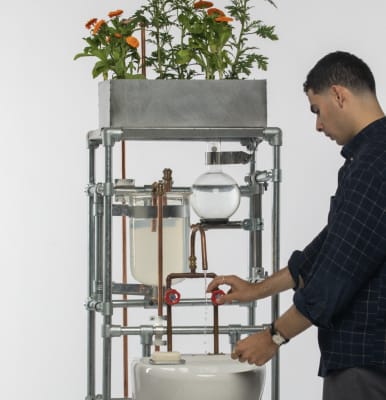
beyond the flush | murky waters run deep
‘Beyond The Flush’ explores the critical intersection of water infrastructure and environmental impact, addressing the dire consequences of water privatisation in England. Amid recent reports of extreme sewage pollution from water companies’ deliberate discharging of waste, this project champions decentralisation as a potential solution. My proposition is centred around the belief that water is a natural resource and shared asset, therefore should be collectively owned by the state or community to eliminate the individual pursuit for profit. This project reimagines a holistic approach to wastewater management and proposes a future where local water management systems seamlessly integrate into our neighbourhoods and homes. The system aims to clean wastewater close to its production using low-tech infrastructure and closed-loop circuits. This structure can empower citizens to take responsibility over their wastewater within a domestic setting and reclaim their right to water as users.
Prefabricated water treatment unit
Prefabricated water treatment unit
Prefabricated water treatment unit
The unit demonstrates how various water purification technologies can function together at different scales. It operates through two distinct loops: the first loop collects and cleans grey water from a user's sink. This water is recycled, filtered, and pumped into a clean water reservoir for reuse. The second loop handles black water, which is too contaminated to clean directly. This water is sent to an 'external treatment' system, represented by plants at the top of the model. The plant roots purify the black water, which is then returned to the clean water reservoir in the user's home to be used again.
Prefabricated water treatment unit
Mapping Site
My proposition is centred around the belief that water is a natural resource and shared asset, therefore, should be collectively owned by the state or community to eliminate the individual pursuit for profit. A key component of the proposal involves the creation of a short film employed as an educational tool exposing the public to the unjust acts of water companies; it advocates for accountability and a complete system overhaul. I propose a future where decentralised water management systems seamlessly integrate into our cities, neighbourhoods and homes by treating wastewater close to its production using low-tech infrastructure like constructed wetlands and biofilm. This approach empowers citizens to manage their water usage and waste disposal and reclaim their right to water by negating the need for privatised infrastructure of water companies.
1:20 Model | Iterating Between Individual and Neighbourhood Scale
Throughout this project is a continuous dialogue and development between different scales, specifically the individual and neighbourgest how a water treatment plant could begin to intervene in these cycles at a domestic scale. ow a water treatment plant could begin to intervene in these cycles at a domestic scale.
Calculating water demand & quantities for the site
Using the UK’s average rainfall data and the number of residents living on this site, I have calculated the current clean water demand for the residents in this area. This demand is currently solely being provided by Thames Water cleaning and distributing river water, however, I have calculated that rain water capture could provide 65% of the clean water demand for this area. If this project is able to integrate other technologies to reuse water more efficiently and minimise the amount of new water each person requires, it is more than feasible to speculate that such a water network could leave the river untouched, both in the extraction of water and discharge of waste water.
1:20 Model | Iterating Between Individual and Neighbourhood Scale
To report inappropriate content, an infringement of copyright, or to report a problem on the Portfolio platform, please contact the Digital Team
